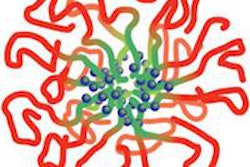Using nanoparticles and alternating magnetic fields, University of Georgia scientists have found that head and neck cancerous tumor cells in mice can be killed in half an hour without harming healthy cells.
The findings, published in Theranostics, mark the first time to the researchers' knowledge that this cancer type has been treated using magnetic iron oxide nanoparticle-induced hyperthermia in laboratory mice.
The researchers successfully used small concentrations of nanoparticles to kill the cancer cells, noted Qun Zhao, lead author and assistant professor of physics, in a press release. They found that the treatment easily destroyed the cells of cancerous tumors that were composed entirely of epithelium (Theranostics, 2012, Vol. 2:1, pp. 113-121).
Other research groups are exploring the use of heated nanoparticles as a potential cancer treatment, and previous studies have shown that high temperatures created by combining magnetic iron oxide nanoparticles with strong alternating magnetic currents can create enough heat to kill tumor cells. Zhao said he is optimistic about his findings, but explained that future studies will need to include larger animals before a human clinical trial could be considered.
For the experiment, researchers injected 0.5 milliliter of nanoparticle solution directly into the tumor site. With the mouse relaxed under anesthesia, they placed the animal in a plastic tube wrapped with a wire coil that generated magnetic fields that alternated directions 100,000 times each second. The magnetic fields produced by the wire coil heated only the concentrated nanoparticles within the cancerous tumor and left the surrounding healthy cells and tissue unharmed.
Zhao said the study paves the way for additional research that might investigate how to use a biodegradable nanoparticle material similar to magnetic iron oxide for other roles in fighting cancer.



















